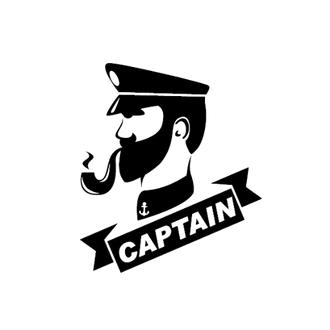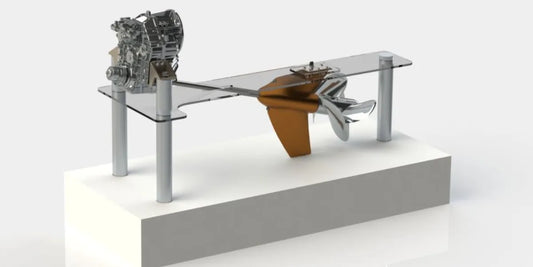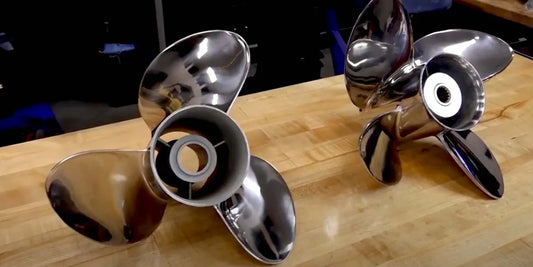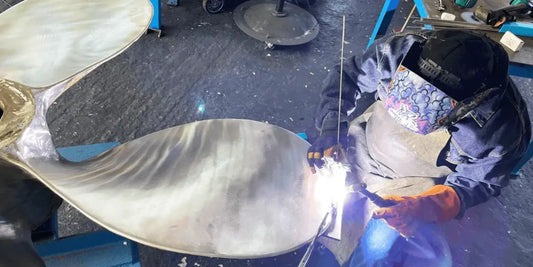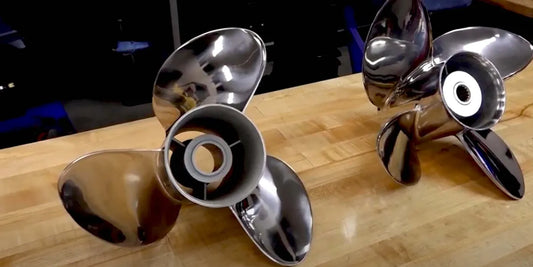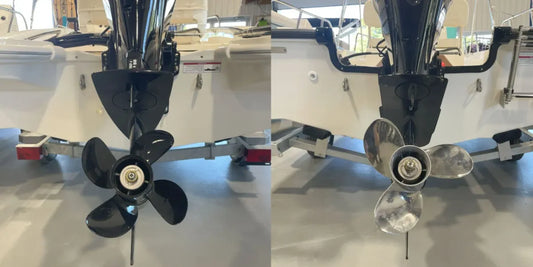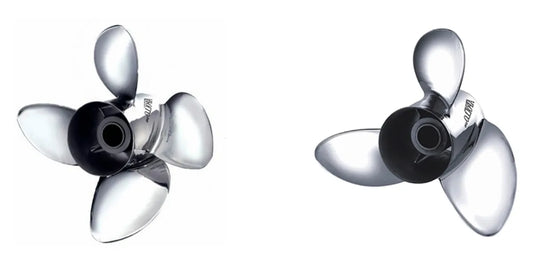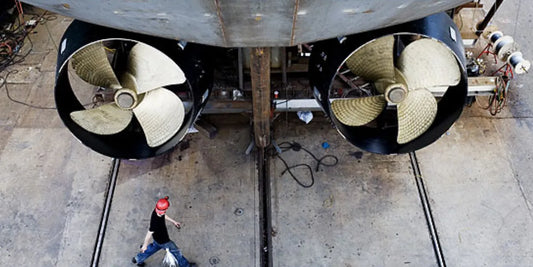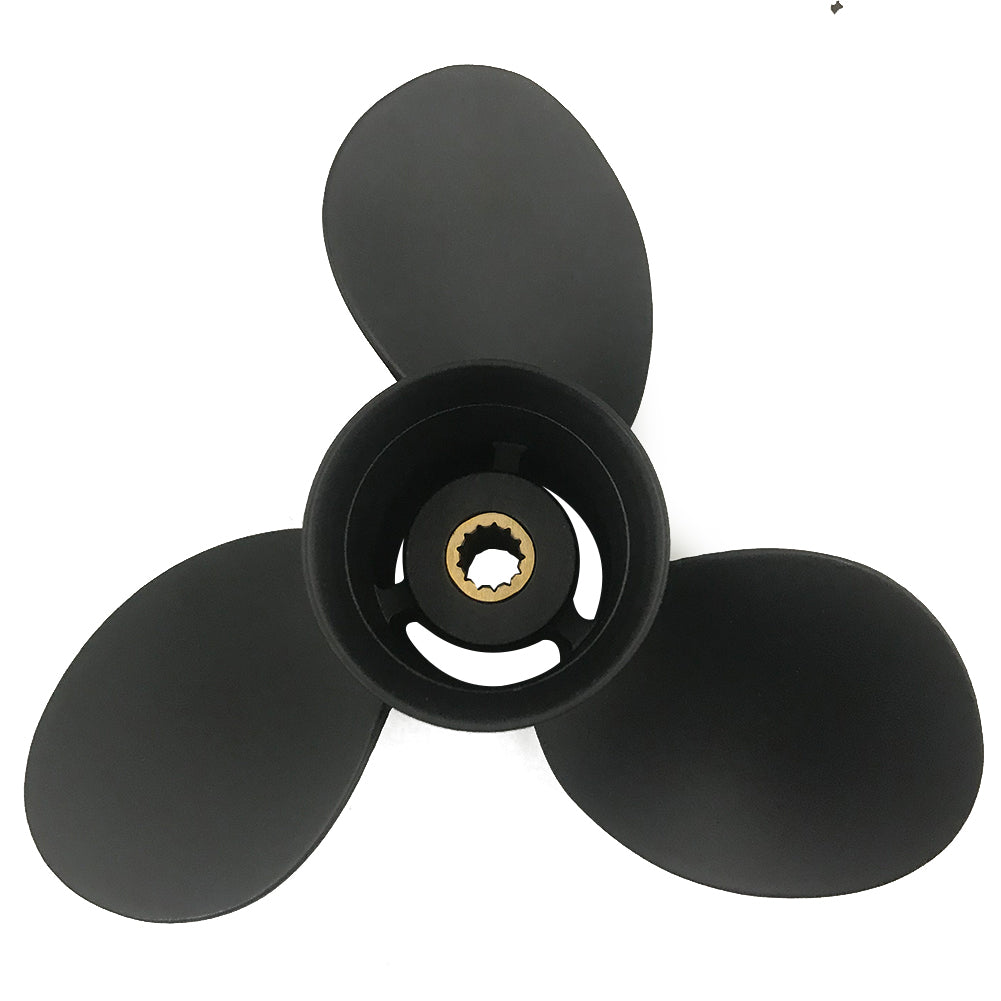It is said that operating tugboats demands nimbleness, power, and dependability, with the power actually emanating from a propeller. It experiences the full weight of the marine environment during operations and thus bears a primary responsibility for the performance and durability of the vessels. Neglecting routine maintenance may be akin to asking for life-costing repairs, unexpected downtime, and a diminution in the vessel's performance. This article shall be considered your complete go-to guide that presents practical and actionable tips for caring for and prolonging the life of your tug boat propeller. From limiting wear and tear, enhancing fuel efficiency, to simply avoiding avoidable setbacks, these professional maintenance tips will surely keep your vessel plowing through the waters for years ahead. Read on to become familiar with regular maintenance that will enhance your propeller's performance and protect your investment.
Understanding Tug Boat Propeller Basics

What is a Tug Boat Propeller?
Tugboat propellers are a crucial component of a tugboat's propulsion system, providing thrust to move heavy loads and offering a level of marine assistance to various operations. Usually made from bronze or stainless steel, these propellers have to resist enormous stresses from the load, considerable power from water resistance, and constant use in almost harsh environments. Because their efficiency must be maximized when towing, pushing, and guiding vessels in harbors or open water, tugboat propellers tend to be larger and much sturdier than those of typical boats. They are selected to provide tugboats with an appropriate balance between power, efficiency, and maneuverability since these are critical factors for tugboat operations. Maintenance, preventive cleaning, and inspections are crucial for maintaining the optimal operational performance of the propeller, which in turn minimizes fuel consumption and reduces delays during operations.
Tug Boat Propeller Types
Tug boat propellers come in diverse varieties to suit the operational needs of such mighty vessels. Among these, the most common are fixed-pitch propellers, controllable-pitch propellers, and azimuth thrusters.
The fixed-pitch types of propeller: Fixed-pitch propellers are those with blades set at a fixed angle for durability and simplicity. These propellers offer maximum efficiency in operation where thrust is constant, and thus they are heavily used in tugboats working in steady-state conditions. Being very tough, they highly resist wear and consequently require little maintenance. This maintenance also translates into a lower cost of upkeep; however, its fixed state becomes a detractor in situations requiring changes.
Controllable-Pitch Propellers (CPP): Controllable-pitch propellers are equipped with blades that operators can adjust to suit the vessel's requirements. This feature enhances maneuverability and fuel economy in complex operations, such as docking or navigating in restricted waters. CPP systems are somewhat more advanced and therefore require meticulous maintenance to function smoothly on a mechanical level.
Azimuth Thrusters: Azimuth thrusters are a cutting-edge form of propulsion that produces thrust in directions of up to 360 degrees. By doing so, they eliminate the necessity for conventional rudders and enable tugboats to hold superior maneuverability and precision. In high-performing harbor tugboats, the azimuth thrusters are being used to the fullest in activities of lateral propulsion or very quick position adjustments. The downside to such advanced technology, however, is the higher cost of investment and maintenance.
The selection of propeller types depends on the vessel's size, its intended operational use, and environmental considerations. Choosing the right kind of propeller ensures that tugboats operate more efficiently and, consequently, achieve cost-effectiveness and operational reliability in the long run.
Impact of Propellers on Tugboats' Performance
Propellers constitute the heart of tugboat propulsion, significantly impacting efficiency, maneuverability, and tug effectiveness under various operational conditions. Modern design and engineering of propellers have therefore evolved to address the specific set of problems presented by multiple maritime cases.
1. Power Usage Efficiency: Modern propellers are built to provide thrust with minimal energy loss. Variable-pitch propellers adjust their blade angle to achieve maximum efficiency at various speeds and loads. With this ability, a tugboat can operate efficiently in various scenarios, such as towing heavy loads or navigating through tight harbors.
2. Maneuverability and Precision: Precise movements are essential for a tug when docking or escorting a large vessel. Modern propulsion systems, such as azimuth thrusters and cycloidal propellers, enable a full 360-degree movement and thus provide great control in challenging environments. Such precision cuts down the margin of error during critical maneuvers.
3. Load Handling and Durability: Today's propeller materials and technologies in construction emphasize durability and performance. High-strength alloys and advanced coatings nowadays resist wear and corrosion initiated under prolonged salt-water exposure and operational stresses. Consequently, better long-term performance and, therefore, less downtime for maintenance form the benefits of such resistant quality.
4. Environmental Impacts: Given the current thrust toward sustainability in the maritime sector, minimal environmental footprint features are being inculcated into propellers. Energy-efficient design and noise reduction technologies not only enhance operational performance but also mitigate their impacts on marine ecosystems, thereby aligning with global conservation priorities.
5. Performance Metrics and Monitoring: One of the significant developments now is the use of aftermarket monitoring tools that provide propeller performance data in real time, allowing operators to make final adjustments for efficiency or to detect a problem that might arise from inefficient operation. Predictive analytics through sensor integration will enable them to operate the system cost-effectively and remain reliable, thereby maximizing the lifespan of the propulsion system.
With an emphasis on these factors, tugboats equipped with modern propellers can enhance their operational capabilities to produce greater efficiency and reliability, meeting the contemporary maritime load demands.
Key Maintenance Practices for Tug Boat Propellers

Regular Inspection and Cleaning
The inspections and cleanings of the tug's propellers must be regular to allow them to be fine-tuned for optimal performance and prevent expensive downtime. Marine growth, debris, and other foreign materials on the surface of a propeller can significantly decrease efficiency, leading to increased fuel consumption and wear on propulsion systems. Scheduled inspections can involve, for instance, searches for any signs of corrosion on the blades, or bending or cracks therein, for such faults can affect operational safety and efficiency if neglected.
Modern anti-fouling coatings and biocidal treatments significantly reduce marine growth, thereby extending the time between cleans. In tandem with these coating technologies, innovative underwater cleaning systems utilize sensors to remove contaminants from propellers while preserving their surfaces.
A recent consideration of thinkers suggests proper maintenance and consistent inspection so that cleaning techniques ensure higher operational efficiency for as much as 15%, considered on the longer end(indeed). This approach would ensure that the tug operates with a reasonable degree of reliability, even in high debris levels or adverse weather conditions, which makes it beneficial for minimizing operational expenses and maximizing vessel performance.
Monitoring Propeller Blade Condition
The assessment of propeller blade condition is vital to improving the operational performance and lifespan of tugboats. Ultrasonic testing systems, combined with the technology of underwater drones equipped with HD cameras, were established to monitor real-time changes in cracks, erosion, or fouling on blades. One study reports that even slight irregularities on the surface, caused by biofouling, can increase drag and fuel consumption by 30%, emphasizing the importance of maintenance and early detection.
Recording thrust efficiency, fuel consumption, and deviations in RPM trends at regular intervals provides a historically data-derived benchmark for diagnosing possible concerns. Predictive analytics software can be used to enhance further blade condition monitoring by forecasting wear based on various criteria, such as water salinity, debris loading, and frequency of operation. Prompt preventive maintenance actions will drastically reduce downtime while elevating energy conservation and cost-effectiveness in marine operations.
Importance of Lubrication
One of the essential roles that lubrication plays is the proper functioning and longevity of maritime machinery. Adequate lubrication minimizes friction between moving parts, which can cause wear and tear, potentially leading to expensive breakdowns. According to industry statistics, approximately 30 percent of mechanical failures are related to improper or no lubrication in marine systems. With the appropriate lubricant selected for the given operational conditions, such as those involving temperature extremes, pressure variations, or exposure to saltwater, the reliability of the equipment is significantly enhanced.
Once subjected to high stress, synthetic oils with nanotechnology are enhanced lubricants, maintaining stability and increasing the intervals of reapplication. Lubrication levels are constantly monitored, and with the addition of an automated delivery system, lubrication application can be ensured while minimizing human error and enabling proactive maintenance. Thus, a good lubrication plan ensures optimum performance and leads to greater cost savings due to reduced forced downtimes of other large marine systems.
Choosing the Right Tug Boat Propeller

Factors Influencing Propeller Selection
Selecting the appropriate propeller for a tugboat is crucial to achieving optimum performance, fuel efficiency, and maneuverability. Many factors must be considered during propeller selection to ensure it is suitable for the vessel's operational requirements and environmental conditions.
Type of Vessel and Function: The very nature of the job carried out by tugboats, that is, if it serves in harbor towing, coastal operation, or deep-sea operation, influences the desired characteristics of the propeller. For example, harbor tugs highly value being maneuverable and having responsive thrust; hence, they may use smaller, higher-pitched propellers, whereas ocean-going tugs often require larger propellers to maintain their speeds.
Power and Torque: Propulsion power provided by the tug's engine directly affects the sizing and blade arrangement of the propeller. If inadequately matched with the propeller, the engine may either overload its maximum permissible power inputs with excessive wear and maintenance costs/or prevent a smooth transfer of power.
Hull Design and Draft: The hydrodynamic properties of the tug vessel, such as hull shaping and draft, in turn, affect propeller efficiency. For instance, deeper drafts might allow bigger diameter propellers, which can aid in pushing heavier towing operations. Conversely, smaller tugs in shallow waters may go for smaller diameter propellers with legitimate nozzle designs.
Operational Environment: The environmental factors in which the tug operates, including currents, water depth, and salinity, are paramount. High-load tasks under challenging environments will require propellers built for durability and corrosion resistance, such as stainless steel alloy propellers.
Thrust and Efficiency Requirements: The required thrust is generated by the towing capacity of the tug called bollard pull, which decides the thrust and efficiency requirements for a propeller. Multi-bladed types or controllable pitch propellers may, however, provide additional control and thrust potential in the demanding operations.
Cavitation and Noise Reduction: On the one hand, cavitation is caused by the formation of vapor bubbles due to pressure differentials around the propeller, which can reduce performance. Additionally, the erosion of materials caused by cavitation also contributes to noise aggravation. State-of-the-art propeller designs employ CFD modeling to minimize cavitation and maximize erosion life.
Maintenance and Lifecycle Costs: In the discussion of costs, it is crucial to consider both long-term operational costs and the initial investment. A propeller design that offers easier maintenance access, minimal fouling, and longer operational life can make strong claims for cost-effectiveness in the long run.
Secondary factors to be considered include vessel efficiency, operational safety, and vessel reliability. Choosing the proper propeller is not just a technical decision, but rather a strategic one for the vessel's long-term performance and profitability.
Understanding Propeller Diameter and Pitch
The term diameter refers to the entire width of the circular path swept by the blades. At the same time, the pitch is defined as the theoretical distance a propeller could ideally move in one complete revolution. Both factors significantly influence the propulsion efficiency and thrust of a vessel, and thus, its overall performance.
A large propeller diameter imparts higher thrust by moving greater volumes of water, making it suited to slower vessels that require maximum pull force, such as tugboats or cargo vessels. In contrast, greater diameters add drag force and are not suitable for ships needing higher speeds. A similar effect is exerted by pitch on power utilization efficiency. High-pitch propellers are speed-oriented and allow high-speed vessels, such as speedboats, to operate at peak efficiency, while low-pitch propellers concentrate on accelerating heavy loads with minimal effort.
Consider, for instance, the tugboats of the 2000s that strike a delicate balance in selecting the optimal diameter and pitch for specialized designs to minimize cavitation energy losses and operate smoothly even under extreme loading. Beyond that, they employ numerical computations and hydrodynamic testing to fine-tune these parameters further, thereby realizing targeted goals — such as fuel savings, reduced maintenance, or enhanced responsiveness under changing marine conditions.
Assessing Different Technologies for Propulsion
In evaluating new propulsion technologies, one must never forget innovative systems that emphasize efficiency, sustainability, and performance. One of the most significant hallmarks of increasing acceptance is hybrid propulsion. They combine a conventional diesel engine with an electric motor, achieving reductions in fuel consumption and emissions. For example, a hybrid system can determine when to use its electric motors, such as while docking or cruising, and thus optimize energy use to meet environmental directives and bottom-line considerations.
With stricter environmental regulations and market demand increasing, it is gaining momentum as an alternative to a fully electric propulsion system. Clean energy sources are employed; for instance, battery storage or renewable inputs might be used to eliminate the exhaust emissions. That makes it key for zero-emission shipping zones. Battery capacity and energy management improvements would further allow for operation even in larger vessels.
The advancement of gas turbine propulsion systems is worth mentioning when discussing high-performance propulsion systems. These systems offer excellent power-to-weight ratios and extremely high reliability, making them well-suited for large vessels that require high speeds or varied operational profiles. However, the podded propulsion units have brought about changes in maneuverability and operational flexibility, as these units are steerable propulsion pods that eliminate the need for rudders, allowing for precise maneuvering in highly constrained waters.
Each propulsion technology offers advantages according to different operational scenarios, with choice being based upon factors like the size of the vessel, the type of use, environmental regulations, and economic considerations in the region. These state-of-the-art solutions will enable operators to reduce carbon footprints, improve operational efficiency, and meet the ever-changing needs of the industry.
Common Problems and Solutions for Tug Boat Propellers

Identification and Rectification of Cavitation Problems
Cavitation remains a significant competing factor in the performance of any tugboat propelling system. The vapor cavities (bubbles) evolve when the water pressure around the propeller goes below the vapor pressure, and these bubbles consequently collapse with considerable energy. This phenomenon reduces the thrust against the tugboat. Similarly, from both short-term and long-term perspectives, the designer shouldn't allow it to damage the propeller blades, thereby incurring higher maintenance costs and profitability losses during downtime periods.
First, detecting cavitation is necessary for its treatment. It generally manifests as irregular vibrations, a strange noise, and major degradation in propeller performance. With the aid of intelligent monitoring systems comprising several sensors, the precautions can be set into motion upon the identification of cavitation as an onset sign.
The steps of solving the cavitation problems begin with studying the propeller arrangement. A change in blade pitch, diameter, or shape could help finish water flow and pressure imbalances. In certain operational conditions, for example, designs with high efficiency, such as the Kaplan or skewed blade, may significantly reduce the chances of cavitation. Additionally, a smooth surface of the propeller should be maintained, eliminating all other surface irregularities to enhance performance.
Aside from the above, operational adjustments also play a role in cavitation management. Under good loading conditions, vessel speed and alignment of the propulsion system are crucial variables to control, thereby mitigating cavitation risks. Keep the propeller clean and check it regularly to ensure optimal performance, and do this to prevent it from deteriorating.
Ultimately, the hydrodynamic analysis must be conducted by a marine engineer or consultant to gain a deeper understanding of the root cause and enhance the design of the specific solution. Advanced simulation tools such as CFD come into play in the diagnosis of cavitation and in the evaluation of remedial actions within a controlled environment. Thus, these aspects of mitigative measures can be controlled to enable the operator to combat cavitation proactively, thereby improving the durability and performance of tugboat propulsion systems.
Going on with Corrosion and Wear
Corrosion and wear may be among other challenges presented to the tug boat propulsion systems, affecting performance and cut short its lifespan. Corrosion occurs due to prolonged exposure, resulting in a chemical reaction between salt and metal. Wear is caused by repeated friction and stresses on the moving parts due to operational demands and environmental conditions.
To combat these issues, operators could apply protective layers over the systems, such as coatings like epoxy paint or protective treatments, to withstand marine environments. Inspections, too, become critical in the early phases of degradation, allowing necessary steps to be taken to prevent it. Using sacrificial anodes made of materials such as zinc or aluminum also acts to protect crucial parts by allowing them to corrode while the protection system remains intact.
From wear and corrosion, the modern materials certainly steal the emphasis. More resistant to environmental corrosion, stainless or composite components will wear less. A timely application of lubrication to moving friction makes the system less susceptible to wear. Modern online monitoring systems can provide information about wear patterns and corrosion trends, enabling the implementation of predictive maintenance strategies to maximize equipment performance and minimize downtime.
Through integration of all such preventive measures, advanced materials, and technologies, operators may then maximize propulsion system life extensions while ensuring that operational efficiencies are not compromised.
When to Change Your Tug Boat Propeller
Changing your tugboat propeller is a monumental decision, involving key considerations in the investigation of improvement and efficiency. As time passes, the damage and general wear and tear decrease the propeller's operational effectiveness, resulting in excessive fuel consumption and reduced maneuverability. Some key indicators include:
Observation of Damage: The propeller should be inspected for any signs of cracks, chips, or bent blades. Even a minor blemish can disrupt the flow of water, leading to vibrations and operational inefficiencies.
Performance Deterioration: The sudden drop in speed and lack of acceleration or irregular thrust resistance could be attributed to propeller wear or imbalance.
Excessive Vibrations: Vibrations are not supposed to persist at any given time when the engines are running, nor should they be loud enough to be heard. If such vibrations continue and originate from an imbalance or damaged propeller, then so does the rest of the Cetacean's panic; for extended periods, it can cause stress to the drivetrain and other load-bearing components.
Material Erosion: Over time, waterborne debris, sand, and other abrasive dynamic factors grind on propeller materials, hence corroding or eroding the very structure of these materials.
Poor Fuel Usage: A damaged or worn-out propeller typically places additional strain on the engine, resulting in increased fuel consumption during operation.
Engine Overheating: A dysfunctional propeller would put excess strain on the engine, thereby causing it to overheat or become increasingly inefficient over time.
In line with this occurrence, regular inspections and the timely replacement of components will maintain operational efficiency and thus avoid costly damage to other parts of the vessel. By watching for these signs and staying ahead of the maintenance schedule, you can maintain optimal propeller performance and ensure your tugboat stays reliably operable under rigorous conditions.
Advanced Technologies in Tug Boat Propeller Design

Innovations in Propeller Engineering
In my experience, there have been significant advances that have improved the efficiency of tugboats. One of the more critical aspects of the design is the emergence of CFD-based methodologies. Using CFD simulations, engineers can analyze water flow and optimize propeller geometry for minimal drag and maximum thrust. This method has led to more efficient propellers, while also ensuring lower fuel consumption, which is crucial in the economics of tugboat operations.
Yet another revolutionary development has been the use of composite materials in propeller manufacturing. Composites have offered manufacturers a better strength-to-weight ratio than traditional metal alloys. These materials provide reduced weight and resistance to corrosion, thereby extending the propeller's life. Additionally, 3D printing, which is highly adaptable for prototyping new designs, has nearly shortened the manufacturing time, allowing for quicker iterations and customized solutions tailored to specific operational requirements.
Hybrid propulsion systems, on the other hand, also deserve mention due to the changes they have created in expectations regarding tug boats' efficiency and sustainability. Using both diesel engines and electric propulsion in combination offers better control of velocity and maneuverability, and lowers emission levels. These innovations make a statement about how cutting-edge technology redefines the potential of tug boat propellers and, therefore, ensures they meet modern-day specifications in maritime operations.
Advantages of Voith Schneider Propellers
I see in VSP a mechanism with unparalleled benefits in terms of precision and maneuverability. The vertical blade arrangement rotates to produce thrust in any direction, eliminating the need for rudders. Instant changes of direction and speed can be achieved; therefore, these are best suited for vessels that require a high degree of maneuverability, such as tugboats, ferries, and offshore support vessels. The magnitude of control VSPs provides increased safety in executing precise maneuvers, especially when sea conditions are complex or the area of operation is limited.
Another big benefit of VSP technology is its efficiency and reliability. Instantaneous thrust means fuel is saved since engineers don't have to strain the engines more than necessary to perform complex maneuvers. And there's always the benefit of reduced operating costs, which also aligns with the programs developing around environmental emission reduction. Furthermore, VSPs boast rugged, tried, and tested engineering that ensures the greatest durability between refits, with minimal maintenance expected, thereby increasing the life expectancy of the entire propulsion system.
Then comes the versatility of the Voith Schneider Propeller, which contributes significantly to maintaining its relevance amidst modern advances in marine technology. Together with hybrid or electric propulsion systems, VSPs can complement sustainability goals in modern marine operations. Their unique provision for smooth, continuous power and superior responsiveness, therefore, allows them to cater to a wide range of vessel types and operational demands, while from a future perspective, they remain an investment in marine technology.
Tug Boat Propeller Technology Trends on the Horizon
Similarly, given the tug industry's commitment to environmental sustainability and energy efficiency, one can foresee its tug propeller technology adopting more advanced propulsion systems. Hybrid and all-electric propulsion would increasingly be installed together with propellers, such as the Voith-Schneider propellers, giving a new meaning to tugboat operation. These systems ensure a reduction in emissions and fuel consumption while providing sufficient power and precision from the tug to meet the usual considerable demands. This aligns with the industry's need to grow in line with the global trend towards green maritime practices and stricter emission regulations.
Another significant trend is the development of innovative propulsion technologies. Operating with intelligent monitoring systems that work closely with advanced propellers, these systems engage in real-time data collection, helping operators further optimize performance and carry out predictive maintenance. This leads to maximizing operational efficiency and vessel uptime, while also reducing unforeseen costs. I believe these can be streamlined into an operational flow that incorporates automation and AI, making the way open toward semi-autonomous or fully autonomous tugboats with propellers that dynamically adjust to various operational requirements.
Lastly, the future designs of propellers are being shaped by material science developments. Now, with the advent of high-strength and corrosion-resistant materials, propellers are designed to resist harsher areas, increasing their life while cutting down on maintenance cost. This will enhance durability and reliability, ensuring that tugboats can operate efficiently in challenging areas. These trends herald an energetic shift in tugboat technology, where an environment-conscious, operationally efficient, and technologically driven mode becomes the driving force of progress.
Reference Sources
-
Propeller Maintenance - Mercury Marine: Offers tips on inspecting propeller blades for damage and maintaining their condition.
-
Taking Care of Your Boat Propellers - Formula Boats: Guides for removing, cleaning, and inspecting propellers for optimal performance.
-
I work as a welder for boat propeller repairs - Reddit: Shares insights on balancing and repairing boat propellers from a professional welder's perspective.
-
Top Maintenance Tips for Extending the Life of Your Mercury Propeller - Buy Propeller: Focuses on cleaning, inspection, and other maintenance practices to prolong propeller life.
-
5 Ways to Extend the Life of Your Aircraft Propeller - Hartzell Propeller: While focused on aircraft propellers, it provides transferable tips like regular inspections and balancing.
Frequently Asked Questions (FAQs)
What does the complete design of a tug boat propeller consist of?
The design of a tugboat's propeller is crucial for achieving maximum thrust and efficiency. Tugboats often require propellers, especially those designed for their high bollard pull and maneuverability while operating. There exist many manufacturers producing 4-bladed or more advanced designs that improve the propulsion system of the vessel. These propellers are capable of rotating efficiently at various speeds to serve the tugboat when towing or pushing other vessels. The blade angle and pitch are also optimized for better performance under varying load conditions.
How does the propeller size influence the tugboat's performance?
Would a bigger propeller work better? The bigger the propeller, the more thrust it produces, which is the very thing needed for towing hefty loads. Furthermore, the size must correlate with the power produced by the engine and the vessel's design. When a too-large propeller increases drag, or a too-small propeller fails to deliver sufficient thrust, one finds oneself in a paradoxical situation. Thus, manufacturers would recommend a particular size depending upon vessel requirements as well as operational tasks for best performance.
What technology is being used by modern tugboat propellers?
Present-day tugboat propellers utilize new and improved technology to enhance efficiency and maneuverability. Some of the recent designs include Kort nozzles that enhance the flow of water around the blades, improving thrust and fuel savings. The newly introduced Voith-Schneider propeller also offers better dynamic positioning, making it easier for the tugboat to maneuver in small spaces. These technologies also reduce maintenance costs by minimizing downtime and enhancing reliability.
What specifications should you consider for a tugboat propeller?
When selecting a propeller for a tugboat, the client would consider several key features. Important considerations include the diameter of the propellers, pitch, blade design, and material. All of these parameters contribute to imparting thrust to the propulsion system and ensure its efficient operation. Another essential factor is ensuring a proper match between the engine and the vessel's shaft sizes to achieve peak efficiency. Different manufacturers will provide detailed specifications to help operators make the best choice for particular uses.
How would the price of a tug boat propeller fluctuate?
The tugboat propeller price may fluctuate significantly due to various factors, including brand, materials, and design complexity. The highest-quality propellers for tugboats come with a high price tag due to their sophisticated engineering and flawless execution. Custom propellers, meant to serve an unusual set of requirements, would add to the cost. The operators should think beyond just the initial cost and consider that fuel prices and maintenance costs may change significantly over time. Therefore, investing in a superior brand propeller will yield better performance outcomes and lower operational costs.
What are the benefits of a high-quality propeller for tugboats?
Investing in a high-quality propeller for tugboats offers numerous benefits, with efficiency being one of the key advantages. A classy propeller increases thrust, thereby improving towing ability. The materials from which the propeller is made, and how it is constructed, contribute to its durability and resistance to various kinds of wear and tear, thereby reducing the need for costly, frequent replacements. Some high-grade propeller designs result in an efficient fuel system, ultimately making it less expensive to maintain the vessel. Improving interface response and vessel maneuvering is another benefit; thereby, the tugboats can glide through harsh environments.
